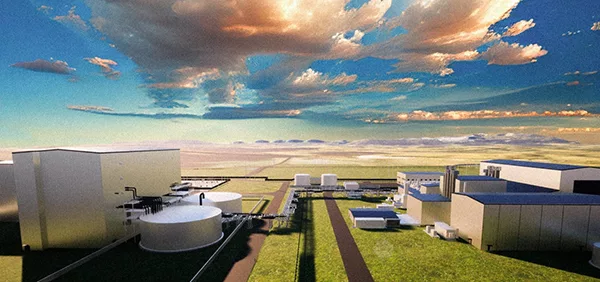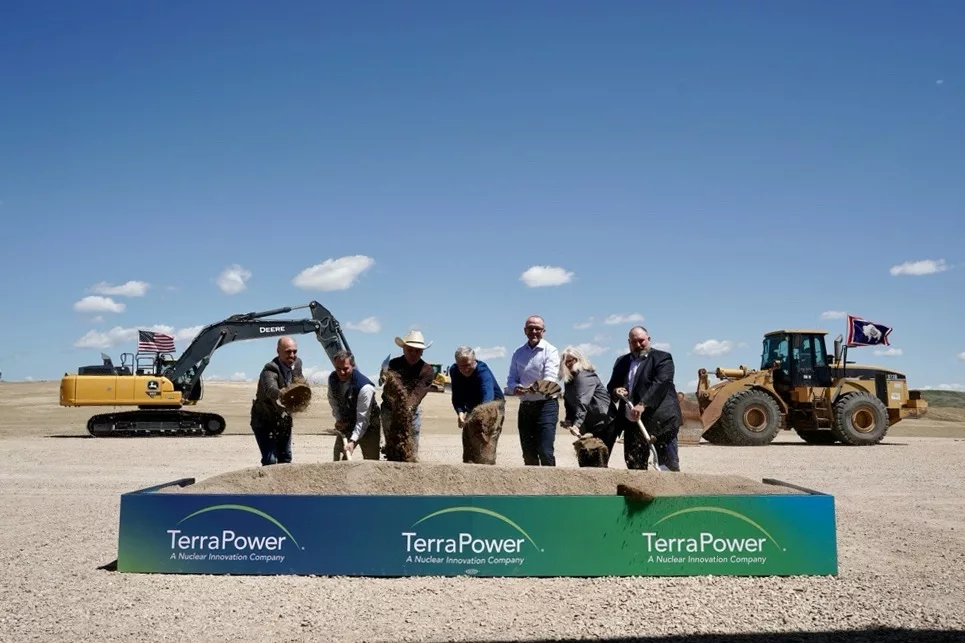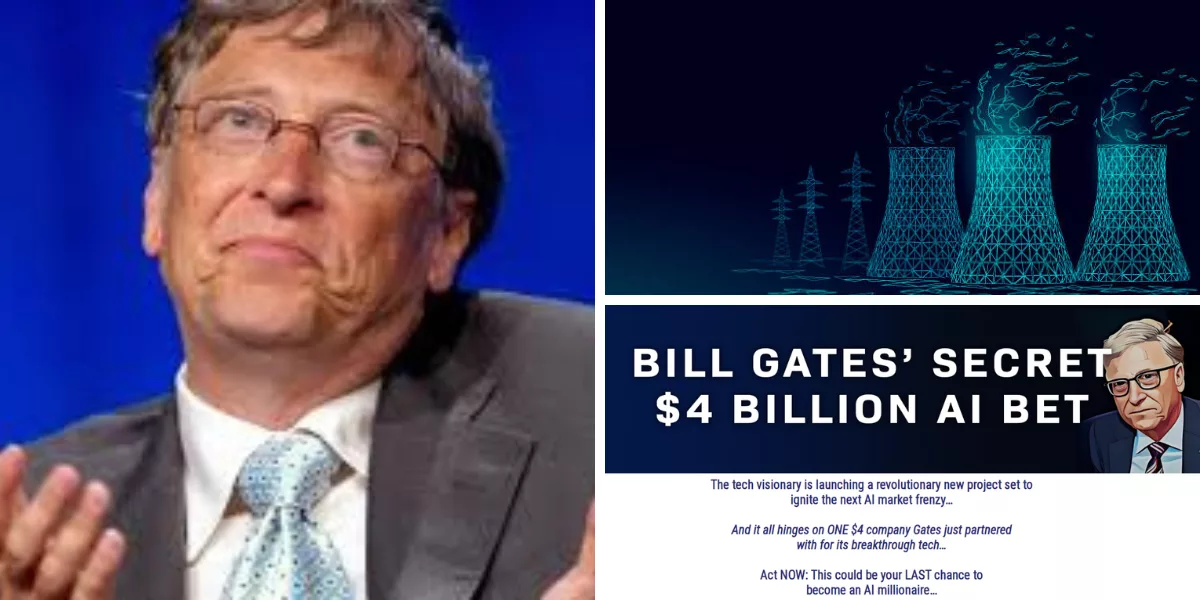Bill Gates may be giving away 99% of his wealth, but the MASSIVE bet he just made isn't being talked about.
It's a groundbreaking project that will power the $15.7 trillion AI revolution, and one “Natrium” facility is at the center of it.
The Teaser
Angel Publishing founding member Brian Hicks believes this bet could go on to become even more valuable than Microsoft.

Investment newsletter publisher, author, and pickleballer, Brian Hicks is a self-proclaimed “perma-bull.” We have previously covered his “Bitcoin Loophole” teaser and Ian King's similar-sounding “AI Energy” Pitch.
For some context, Microsoft has a current market cap of $3.2 trillion. What could be bigger?
Artificial intelligence (AI) is a prospective $15.6 trillion market that is expanding by 20-30% per year.
Gates and his ex-con investment advisors understand this, and it's why they are using 44 acres of his massive 275,000-acre farmland portfolio to build the “most advanced nuclear facility in the world.”

It’s called the “Natrium” facility, and it's designed to solve AI's biggest challenge: energy.
A Miracle Fuel
The play is obvious…
Rather than trying to win the artificial general intelligence (AGI) and artificial superintelligence (ASI) arms races, Gates wants to meet the massive energy needs they depend on.
It's not all that different from Microsoft providing the operating system that PCs run on, rather than building the computers themselves.
But what exactly is “Natrium?“
Brian is talking about enriched uranium, which is the stuff that nuclear energy runs on.
Nuclear power produces zero emissions, and it is more potent than oil, which is why Brian Hicks calls it “a miracle fuel.”
This makes it ideal for power-hungry AI applications, like ChatGPT, which uses as much power in a single day as 33,000 U.S. households do in an entire year.
The “Natrium” facility referenced is TerraPower's first nuclear reactor near the site of an old coal plant in Kemmerer, Wyoming.

However, TerraPower isn't the company being teased, as it is still privately held.
Instead, what's being teased is a $4 company that TerraPower just partnered with for its breakthrough tech.
The Pitch
As is usually the case, the teaser is the bait, and the pitch is the hook.
This comes in the form of an urgent report called “Bill Gates' Secret Nuclear Partner:
The Tiny Firm Powering the AI Revolution.”

It is only available to subscribers of the New World Assets newsletter, which identifies companies poised to dominate the global resource race…before they make headlines. The cost to join is $1,999.
A Ticking Time Bomb for America’s Future
AI could be the straw that makes the lights go out.
When it comes to the energy grid, it appears that we find ourselves in a bit of a pickle.
In simple terms, over 70% of the U.S. electricity grid is more than 25 years old. It was barely built for the Internet, never mind AI data centers that consume as much electricity as entire countries.
At the same time, the country needs more data centers to keep up with AI growth, or risk falling behind.
Neither renouncing AI leadership nor rolling blackouts is an attractive choice.
The alternative put forward by Brian Hicks, is a cutting-edge technology for powering AI data centers, and the entire U.S. electric grid.
He's talking about Small Modular Reactors (SMRs), which big tech is going all-in on.
AI Rocket Fuel
At this point, it's well known that the so-called “Magnificent Seven” of Apple, Microsoft, Google, Nvidia, Meta, and Tesla could be renamed the “Radioactive Seven,” given how hot they are on SMRs.
Google, Amazon, Microsoft, and Meta have partnerships or investments in energy providers with nuclear ambitions.
However, Bill Gates' “Natrium” facility in Wyoming may be a step ahead of all of them.
Unlike conventional nuclear reactors, SMRs require enriched uranium specifically designed to meet their unique energy needs.
Unfortunately, the U.S. doesn’t produce enriched uranium in any meaningful capacity. Instead, Russia currently controls about 40% of the global market.
But one little-known firm has developed “a groundbreaking process to produce this rare, high-grade fuel, faster, cheaper, and at scale.”
Bill Gates' TerraPower has locked in a 10-year supply deal with this company to fuel its Natrium facility, and Brian believes it's about to make investors a fortune.
Revealing Brian Hicks' AI Natrium Bet
Here is everything we know about the company “the future of AI depends on“.
- This company’s technology eliminates America’s reliance on foreign suppliers like Russia, securing a domestic supply of advanced nuclear fuel.
- Its patented laser nuclear enrichment technology is faster and more precise than outdated methods like gaseous centrifuge and gaseous diffusion.
- It has a market cap of $375 million, making this firm 8,400x smaller than Microsoft.
Brian's Natrium bet is ASP Isotopes Inc. (Nasdaq: ASPI).
- ASP describes itself as “a leader in isotope enrichment technology,” vital to various industries.
- Contrary to Brian's claims, the company doesn't have any pending or attributed patents, instead, it relies on trade secrets and other intellectual property laws to protect its IP.
- ASP has a current market cap of $463 million, up 30% this year.
The Key to the AI Revolution?
ASP is the toughest kind of business to value.
A pre-commercial stage technology company that serves highly-regulated industries.
Revenue is minimal, earnings are non-existent, and will be for a while. All we have to go on is the intellectual property and our own judgment.
Fuzzy Panda Research doesn't think much of it, and even accuses ASP of hocking old, disregarded enrichment technology as a new, cutting-edge uranium enrichment method.
There is also the matter of ASP's much-hyped partnership with TerraPower simply being a Memorandum of Understanding. It's not a definitive purchase agreement, just a term sheet under which TerraPower would buy high-assay low-enriched uranium (HALEU), if any were to be produced.
Tellingly, buried deep inside ASP's most recent 10-K, we discover that the company acquired its technology at a competitive auction in South Africa for ZAR 11,000,000 or approximately $734,000.
What do the books say?
At the end of 2024, the company had nearly $62 million in cash on its balance sheet, with $43 million in total liabilities, including a huge $33 million outstanding convertible note.
Given ASP's current annual run-rate of$20-30 million. It has at most 12-24 months before it needs to go back to investors, hat-in-hand, to ask for more money.
This doesn't paint a pretty picture, but my biggest concern is the time it will take to get to material commercial production of HALEU…if the tech works.
Management expects its first Pretoria, South African enrichment facility to generate a commercial supply starting this year, but this sounds overly optimistic.
It is an interesting space, as the need for alternative energy innovations and solutions is high. But I would hold off on investing in ASP, at least until the technology is proven to work and production begins.
Quick Recap & Conclusion
- The man behind Angel Publishing, Brian Hicks, is teasing a groundbreaking project that will power the $15.7 trillion AI revolution, and one “Natrium” facility is at the center of it.
- “Natrium” is enriched uranium made specifically for Small Modular Reactors (SMRs) that will meet AI's heavy energy needs, and one company is closer than any other to producing it.
- Its name is only revealed in a report called “Bill Gates' Secret Nuclear Partner:
The Tiny Firm Powering the AI Revolution.” For the price of $1,999, we can subscribe to the New World Assets newsletter and get our hands on it. - But before you do, we gave you Brian's “Natrium” bet for free, it's ASP Isotopes Inc. (Nasdaq: ASPI).
- ASP is pre-commercial stage, with unproven technology, and a high annual burn rate. I would hold off on investing in the company, at least until the technology is proven to work and production begins.
Is uranium enrichment technology the key to meeting future energy demand? Drop your thoughts in the comments.

